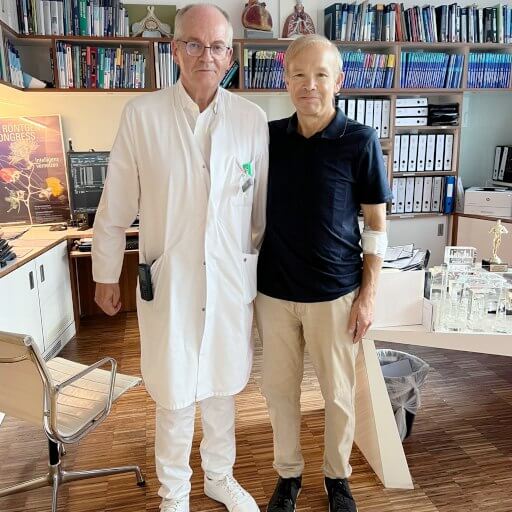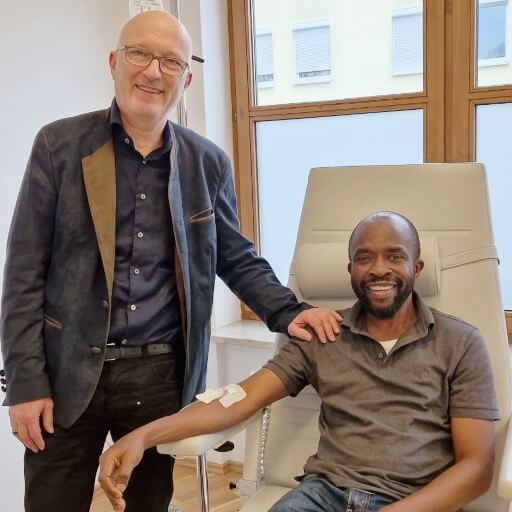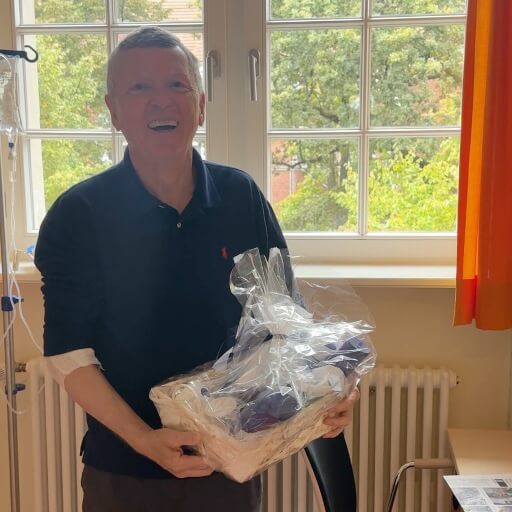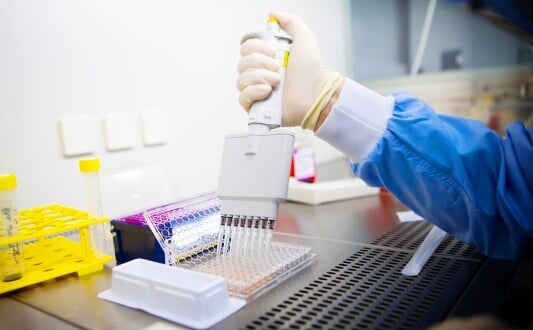A radiation therapist is an important member of the medical team that treats prostate cancer. Due to the proximity of the prostate to the bladder, penis, and intestines, radiation therapy may cause complications such as urinary incontinence, erectile dysfunction, and post-radiation rectal and pelvic tissue inflammation (proctitis and paraproctitis). During treatment in Germany, doctors place a rectal spacer between the prostate and other organs, such as SpaceOAR Hydrogel or Barrigel, which reduces the risk of complications in 98.5% of men. A hydrogel spacer for prostate cancer represents one of the most significant advancements in radiation therapy, allowing doctors to deliver higher, more precise radiation doses while protecting surrounding tissues.
Schedule Treatment with Hydrogel
The role of radiation therapy in prostate cancer treatment
In early-stage cancer, radiation therapy becomes the method of choice if a man wants to move from watchful waiting directly to treatment. In the advanced stages of the disease, radiation therapy helps to destroy the remaining cancer cells after surgery or inhibits tumor growth if surgery is not planned. Depending on the clinical situation, doctors may conduct external beam radiation therapy using special equipment or internal radiation therapy with the source placed inside the patient's body.
External beam radiation therapy for prostate cancer
- Hypofractionated stereotactic body radiation therapy (SBRT) is a safe radiation technique for men with small, non-metastatic tumors. This therapy may also be used for symptom relief in patients with advanced cancers with significant prostate enlargement. Depending on the characteristics of the tumor, prostate SBRT may include a course of 5 or 20 fractions. You may have heard of SBRT under the names Gamma Knife, CyberKnife, X-Knife, and Clinac. All of these are devices for SBRT.
- Intensity-modulated radiation therapy (IMRT) uses CT scans to create a 3D model of a specific man's prostate. The model takes into account the prostate volume and the size and location of the tumor. Given this information, the computer program calculates the radiation dose, the direction of movement of the radiation beams, and the intensity of each of them.
- VMAT RapidArc technology can be used when cancer has spread to the lymph nodes. This is a type of IMRT that allows doctors to simultaneously irradiate several malignant foci, including small and deep-seated metastases. The RapidArc system takes about a minute to create a 360-degree radiation field around a patient, so the procedure is 2-8 times faster than conventional IMRT.
- Proton therapy uses accelerated protons instead of X-rays for irradiation. Protons give up their energy only after reaching the tumor, as a result of which the healthy tissues in their way remain intact.
Interstitial radiation therapy for prostate cancer
- Low-dose-rate brachytherapy is the placement of low-activity radioactive seeds in the prostate that do not require to be further removed. Irradiation occurs within a year, after which these seeds lose their radioactive properties.
- High-dose-rate brachytherapy is the implantation of highly active radioactive seeds for 20-30 minutes, after which they are immediately removed. Whenever required, a man can undergo several such procedures.
All types of brachytherapy are performed at a hospital under general anesthesia. After placing a radioactive source inside a man's body, doctors supervise him for a while because of the risk of bleeding and infectious complications.
"Hydrogel treatment for prostate cancer makes it possible to make all types of radiation therapy safer".

Safe use of hydrogel spacers in prostate cancer radiotherapy
The principle of operation
A prostate cancer hydrogel spacer is recommended for nearly all patients undergoing radiation therapy, as studies show it significantly reduces both short-term and long-term side effects. In the name "SpaceOAR™ Hydrogel", SpaceOAR literally means "creating a safe zone around an organ that is at risk of being damaged during radiation therapy." When irradiating the prostate, this is the rectum, the lymph nodes of the small pelvis, and the nerve endings that are responsible for urination and erection.
A rectal spacer physically separates the exposed prostate gland from healthy organs by a distance of approximately 1.3 cm. With modern types of radiation therapy, such as SBRT or IMRT, this is enough to completely protect them.
In addition to physically increasing the distance between the prostate and healthy tissues, rectal hydrogel spacers partially absorb and neutralize radiation propagating in an undesirable direction.
Types of prostate cancer hydrogel spacers
- Gel material based on polyethylene glycol (PEG) , whose commercial name is SpaceOAR Hydrogel. This is the first liquid rectal spacer in the history of oncology that was approved for use in Europe in 2010. In 2015, the SpaceOAR gel received FDA approval and was also used in the US.
- Non-animal stabilized hyaluronic acid (NASHA), whose commercial name is Barrigel. This is a newer drug based on clinical results from SpaceOAR Hydrogel. Barrigel was approved for use in Europe in 2020 and completed clinical trials in the US in the summer of 2022. Because of the drug's high level of safety, it can be used by both adults and children.
When considering Barrigel vs SpaceOAR, patients should know that Barrigel offers clinicians more flexibility in shaping the spacer to match individual anatomy, while SpaceOAR was the first FDA-approved option with a longer clinical history. The hyaluronic acid spacer more closely matches the size of the prostate and anatomical features of the rectum, thereby more securely covering the surface of the latter.
SpaceOAR Hydrogel remains in the human body for approximately 6 months, but with the injection of hydrogel spacer Barrigel, this period is extended to 6-12 months (the duration can be purposefully changed by using biopolymer particles of varying sizes). In both cases, there is enough time for a man to complete the full course of radiation therapy. In the future, the spacer will dissolve on its own, so it is not necessary to carry out a procedure to remove it.
How is hydrogel injected in prostate cancer patients?
SpaceOAR and Barrigel hydrogel are injected transperineally, that is, using a puncture needle through a small puncture in the perineum. The Barrigel and SpaceOAR procedures can be performed in advance, on an outpatient basis, or directly at the hospital where a man plans to undergo his radiation therapy for prostate cancer. Depending on the clinical case, local, regional, or general anesthesia can be used.
SpaceOAR and Barrigel are injected under ultrasound guidance, and the doctor injects about 10 ml of the drug. At the same time, SpaceOAR Hydrogel must be injected fairly quickly since its components quickly polymerize and acquire a high density. Barrigel can be injected more slowly, gradually adjusting the shape and volume of the spacer until an optimal result is achieved. Excess Barrigel can be removed with a puncture needle, while the removal of too much SpaceOAR Hydrogel requires surgery. The procedure of hydrogel spacer insertion typically takes 30-45 minutes and is performed on an outpatient basis, allowing patients to return home the same day with minimal disruption to their daily routine.
When using SpaceOAR Hydrogel, radiation therapy can be started the next day after the procedure because, for the final formation of the rectal spacer, excess fluid must be absorbed, with which doctors previously separated the prostate and rectum. With NASHA-based products, doctors do not have to wait. Due to its density and viscosity, hyaluronic acid is able to independently move the intestines away from the prostate and fix them in the desired position.
The use of rectal spacers, including hydrogel, for prostate cancer treatment provides the following benefits:
- Reducing the risk of developing radiation proctitis and paraproctitis
- Maintain normal bowel function
- Reliable urinary control and urinary incontinence prevention
- Prevention of the development of erectile dysfunction
According to the results of a large-scale clinical trial of Barrigel, in 98.5% of men, the dose of unwanted radiation to healthy tissues surrounding the prostate was reduced by an average of 85%. It is quite possible that with the improvement of the technical skills of surgeons who implant a rectal spacer, this figure could reach 100%. The SpaceOAR hydrogel spacer for prostate treatment has been used in over 100,000 patients worldwide, with clinical studies demonstrating up to 73% reduction in rectal radiation exposure.
| Feature | SpaceOAR Hydrogel | Barrigel | Radiotherapy Without Spacers |
|---|---|---|---|
| Radiation Reduction to Healthy Tissue | Up to 73% reduction in rectal radiation exposure | 85% average reduction in 98.5% of men | No reduction |
| Risk of Complications | Significantly reduced risk of proctitis, urinary incontinence, and erectile dysfunction | Significantly reduced risk of proctitis, urinary incontinence, and erectile dysfunction | Higher risk of all radiation-related complications |
| Clinical Adaptability | First FDA-approved option with longer clinical history | Better anatomical conformity, easier modification after insertion | Limited ability to adapt treatment to protect organs |
| Treatment Flexibility | Allows for higher, more precise radiation doses | Allows for higher, more precise radiation doses with better anatomical conformity | May require lower radiation doses to minimize damage to surrounding tissues |
Schedule Treatment with Hydrogel
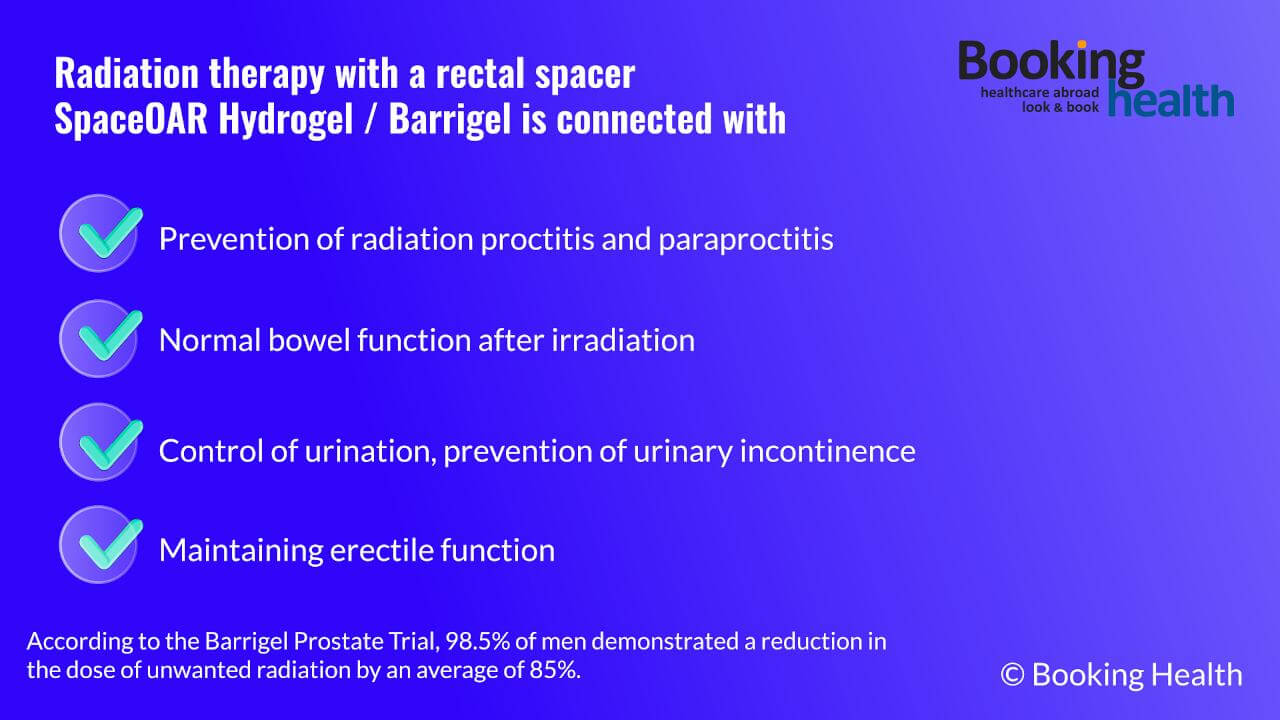
Specialized clinics for prostate cancer treatment
European hospitals are traditionally leaders in prostate cancer treatment, as the average 5-year survival rate here reaches 83%, and when treated at specialized centers, the results are even better. When undergoing your treatment at hospitals in Germany, you can benefit from modern medicines, undergo your surgery using the da Vinci robotic system, and undergo your radiation therapy with hydrogel and other rectal spacers. The following hospitals specialize in prostate cancer treatment:
- Helios Hospital Berlin-Buch, Department of Urology
- University Hospital of Ludwig Maximilian University of Munich, Department of Adult and Pediatric Urology, Andrology
- University Hospital Ulm, Department of Adult and Pediatric Urology
- Urology Clinic Munich-Planegg Munich, Department of Adult and Pediatric Urology, Andrology
- Charite University Hospital Berlin, Department of Adult and Pediatric Urology, Andrology
The cost of SpaceOAR hydrogel and Barrigel varies between medical facilities. Foreign patients can seek medical attention at a German hospital to receive comprehensive prostate cancer treatment, or they can plan only a course of safe radiation therapy using a rectal spacer there.
How to undergo your prostate cancer treatment abroad?
You can make your appointment for diagnostics and treatment in Germany through the Booking Health website. On our website, you will find complete information about hospitals and doctors who specialize in prostate cancer treatment and radiation therapy in particular. You can also find out how much treatment with SpaceOAR Hydrogel costs on the Booking Health website. You can choose a medical facility on your own or seek advice from a Booking Health specialist. You will be provided with up-to-date information on the treatment success rates and the availability of the method at specific clinics.
The specialists at the Booking Health company will also help you with the following important issues:
- Preparation of a treatment program without repeating previous diagnostic examinations
- A remote consultation with an attending physician whenever required
- Control of the cost of services provided by the hospital and exclusion of high taxes for foreign patients (saving up to 50% of the original price)
- Making an appointment on your preferred dates, including urgent treatment
- Communication with the hospital after the completion of your course of treatment
- Assistance in buying and forwarding medicines to continue treatment at home
- Control of invoices and return of unspent deposit funds
- Organization of additional diagnostic procedures or stages of treatment
- Top-class service, including booking apartments, airline tickets, and transfers
- Translation of your medical documents and interpreter services
Your personal medical coordinator will supervise all stages of your treatment, consulting independent Booking Health doctors if necessary. You will be advised and supported until the completion of your treatment and your successful return home.
Schedule Treatment with Hydrogel
Patient Journeys with Booking Health
Frequently asked questions of our patients with prostate cancer
Send request for treatmentA hydrogel spacer is a medical device inserted between the prostate and rectum before radiation therapy. The two main types are SpaceOAR Hydrogel (polyethylene glycol) and Barrigel (hyaluronic acid).
The spacer physically separates the prostate from surrounding organs by about 1.3 cm, creating a protective buffer zone that shields healthy tissues from radiation damage while also partially absorbing radiation.
Hydrogel spacers reduce the risk of rectal inflammation, help maintain normal bowel function, prevent urinary incontinence, preserve erectile function, and reduce unwanted radiation to healthy tissues by an average of 85%.
The procedure involves injecting approximately 10 ml of hydrogel through the perineum using ultrasound guidance under anesthesia. Radiation therapy begins either immediately or the next day, depending on the type of spacer used.
The procedure is performed under medical supervision due to potential risks of bleeding and infectious complications, though hydrogel spacers generally have a high safety profile.
Choose treatment abroad and you will be sure to get the best results!
Authors:
This article was edited by medical experts, board-certified doctors Dr. Nadezhda Ivanisova, and Dr. Bohdan Mykhalniuk. For the treatment of the conditions referred to in the article, you must consult a doctor; the information in the article is not intended for self-medication!
Our editorial policy, which details our commitment to accuracy and transparency, is available here. Click this link to review our policies.
Sources:
International Journal of Radiation Oncology, Biology, Physics
Read:
Revolutionary Immunotherapy Treatments for Prostate Cancer in Germany
Actinium-225 PSMA Therapy: Revolutionizing Treatment for Metastatic Prostate Cancer
Lutetium 177-PSMA: a new generation drug for prostate cancer treatment
Article menu:
Don't know where to start?
Contact Booking Health
